Field Measurement and Research on Environmental Vibration due to Subway Systems: A Case Study in Eastern China
Abstract
:1. Introduction
2. Field Measurement Information
3. Results
3.1. Vibration Response in the Subway Tunnel
3.2. Vibration Response on the Ground
3.3. Vibration Response in the Building
4. Discussion
4.1. Characteristic of the Vibration Attenuation Transmitted from Subway
4.2. Vibration Isolation Design
5. Conclusions
- (a)
- The reduction of extreme values of vibration acceleration amplitude is observed significantly with distance from the vibration source, especially when vibration wave spreads between the track and ballast bed. In other words, the most prominent and visible attenuation of vibration is from the track to the ballast bed.
- (b)
- The ground-borne vibration would quickly decrease with distance from the centerline of the subway tunnel, and the decay ratio of the vibration increases with the increase in frequency range, similar to that in tunnel.
- (c)
- The measured attenuation value of indoor vibration was approximate 0.76 dB on average between each floor from 1st floor to 3rd floor, and there is little difference between the outdoor vibration and the corresponding indoor vibration on the 1st floor.
- (d)
- It is recommended to take a construction gauge of 20–25 m outside of the tunnel. Further, reducing vibration source excitation intensity is the most effective vibration isolation method, especially track structural transformation.
Author Contributions
Funding
Acknowledgments
Conflicts of Interest
References
- Xu, R.; Li, X.; Yang, W.; Jiang, C.; Rabiei, M. Use of local plants for ecological restoration and slope stability: A possible application in Yan’an, Loess Plateau, China. Geomat. Nat. Hazards Risk 2019, 10, 2106–2128. [Google Scholar] [CrossRef]
- Chao, Z.; Wang, Y.; Moore, J.A.; Sanayei, M. Train-induced field vibration measurements of ground and over-track buildings. Sci. Total Environ. 2016, 575, 1339–1351. [Google Scholar]
- Connolly, D.P.; Marecki, G.P.; Kouroussis, G.; Thalassinakis, I.; Woodward, P.K. The growth of railway ground vibration problems—A review. Sci. Total Environ. 2016, 568, 1276–1282. [Google Scholar] [CrossRef] [PubMed]
- Eitzenberger, A. Train-Induced Vibrations in Tunnels: A Review; Luleå Tekniska Universitet: Luleå, Sweden, 2008. [Google Scholar]
- Stiebel, D.; Muller, R.; Bongini, E.; Ekbald, A.; Coquel, G.; Alguacil, A.A. Definition of Reference Cases Typical for Hot-Spots in Europe with Existing Vibration Problems. Rivas Project SCP0-GA-2010-265754; Deliverable D1.5. Report to the EC. 2012. Available online: http://www.rivas-project.eu/fileadmin/documents/rivas_db_wp1_d1_5_v05_definition_hotspots.pdf (accessed on 20 November 2019).
- Zhang, Z.L.; Cui, Z.D. Dynamic Response of Soil around the Tunnel Under Subway Vibration Loading. In Proceedings of the GeoShanghai International Conference, Shanghai, China, 27–30 May 2018; pp. 53–61. [Google Scholar]
- Zhou, X.; Zhao, X.; Han, J.; He, Y.; Wen, Z.; Jin, X. Study on Transient Rolling Noise Characteristics of Subway Wheel with Rail Corrugation. J. Mech. Eng. 2018, 54, 196–202. [Google Scholar] [CrossRef]
- François, S.; Pyl, L.; Masoumi, H.R.; Degrande, G. The influence of dynamic soil–structure interaction on traffic induced vibrations in buildings. Soil Dyn. Earthq. Eng. 2007, 27, 655–674. [Google Scholar] [CrossRef]
- Yao, K. Research Development of Subway Vibration Impact on Environment. In Proceedings of the 23 International Congress on Sound &Vibration, Athens, Greece, 10–14 July 2016. [Google Scholar]
- Amado-Mendes, P.; Costa, P.A.; Godinho, L.M.; Lopes, P. 2.5D MFS–FEM model for the prediction of vibrations due to underground railway traffic. Eng. Struct. 2015, 104, 141–154. [Google Scholar] [CrossRef]
- Jones, S. Ground Vibration from Underground Railways: How Simplifying Assumptions Limit Prediction Accuracy; University of Cambridge: Cambridge, UK, 2010. [Google Scholar]
- Federal Railroad Administration. High-Speed Ground Transportation Noise and Vibration Impact Assessment; U.S. Department of Transportation: Washington, DC, USA, 2012.
- Verbraken, H.; Lombaert, G.; Degrande, G. Verification of an empirical prediction method for railway induced vibrations by means of numerical simulations. J. Sound Vib. 2011, 330, 1692–1703. [Google Scholar] [CrossRef]
- With, C.; Bodare, A. Prediction of train-induced vibrations inside buildings using transfer functions. Soil Dyn. Earthq. Eng. 2007, 27, 93–98. [Google Scholar] [CrossRef]
- Federal Transit Administration (USA). Transit Noise and Vibration Impact Assessment; The Administration: Washington, DC, USA, 2006.
- Lai, C.G.; Callerio, A.; Faccioli, E.; Morelli, V.; Romani, P. Prediction of railway-induced ground vibrations in tunnels. J. Vib. Acoust. 2005, 127, 503–514. [Google Scholar] [CrossRef]
- Gupta, S.; Degrande, G.; Lombaert, G. Experimental validation of a numerical model for subway induced vibrations. J. Sound Vib. 2009, 321, 786–812. [Google Scholar] [CrossRef]
- Lombaert, G.; François, S.; Verbraken, H.; Degrande, G.; Thompson, D.J. Numerical, experimental and hybrid methods for the prediction of railway-induced ground vibration. In Proceedings of the 9th International Conference on Structural Dynamics, EURODYN, Porto, Portugal, 30 June–2 July 2014; pp. 91–99. [Google Scholar]
- National Environmental Protection Agency. Measurement Method of Environmental Vibration of Urban Area; GB10071-88; Press of China Standards: Beijing, China, 1989.
- Fiala, P.; Degrande, G.; Augusztinovicz, F. Numerical modelling of ground-borne noise and vibration in buildings due to surface rail traffic. J. Sound Vib. 2007, 301, 718–738. [Google Scholar] [CrossRef]
- Ding, D.Y.; Liu, W.N.; Gupta, S.; Lombaert, G.; Degrande, G. Prediction of vibrations from underground trains on Beijing metro line 15. J. Cent. South Univ. Technol. 2010, 17, 1109–1118. [Google Scholar] [CrossRef]
- Wei, K.; Zhao, Z.; Du, X.; Li, H.; Wang, P. A theoretical study on the train-induced vibrations of a semi-active magneto-rheological steel-spring floating slab track. Constr. Build. Mater. 2019, 204, 703–715. [Google Scholar] [CrossRef]
- Zhou, M.; Wei, K.; Zhou, S.; Xiao, J.; Gong, Q. Influence of different track types on the vibration response of the jointly-built structure of subway and the buildings. China Railw. Sci. 2011, 32, 33–40. [Google Scholar]
- Connolly, D.; Giannopoulos, A.; Forde, M.C. Numerical modelling of ground borne vibrations from high speed rail lines on embankments. Soil Dyn. Earthq. Eng. 2013, 46, 13–19. [Google Scholar] [CrossRef]
- Andersen, L.; Nielsen, S.R.K. Reduction of ground vibration by means of barriers or soil improvement along a railway track. Soil Dyn. Earthq. Eng. 2005, 25, 701–716. [Google Scholar] [CrossRef]
- Coulier, P.; François, S.; Degrande, G.; Lombaert, G. Subgrade stiffening next to the track as a wave impeding barrier for railway induced vibrations. Soil Dyn. Earthq. Eng. 2013, 48, 119–131. [Google Scholar] [CrossRef]
- Thompson, D. Railway Noise and Vibration. Mechanisms, Modelling and Means of Control; Elsevier Ltd.: Oxford, UK, 2009. [Google Scholar]
- Xu, S.Y.; Jiang, C.; Huang, L. Public health impacts from subway noise: Case study Hong Kong. J. Acoust. Soc. Am. 2019, 145, 1867. [Google Scholar] [CrossRef]
- Sadeghi, J.; Hasheminezhad, A. Correlation between rolling noise generation and rail roughness of tangent tracks and curves in time and frequency domains. Appl. Acoust. 2016, 107, 10–18. [Google Scholar] [CrossRef]
- Bejger, A.; Chybowski, L.; Gawdzińska, K. Utilising elastic waves of acoustic emission to assess the condition of spray nozzles in a marine diesel engine. J. Mar. Eng. Technol. 2018, 17, 153–159. [Google Scholar] [CrossRef]
- Luo, D.; Su, G.; Zhang, G. True-Triaxial Experimental Study on Mechanical Behaviours and Acoustic Emission Characteristics of Dynamically Induced Rock Failure. Rock Mech. Rock Eng. 2019, 1–19. [Google Scholar] [CrossRef]
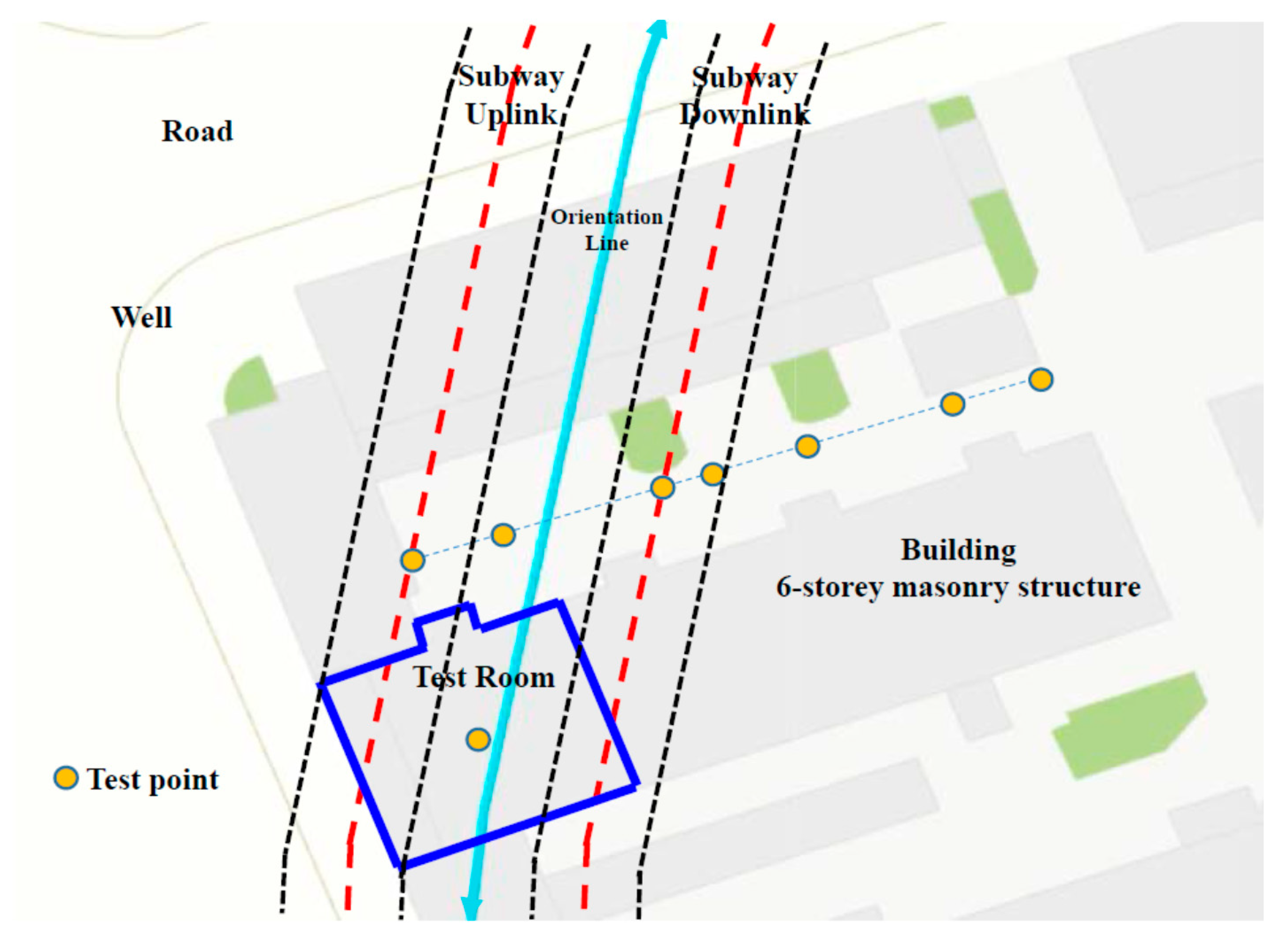
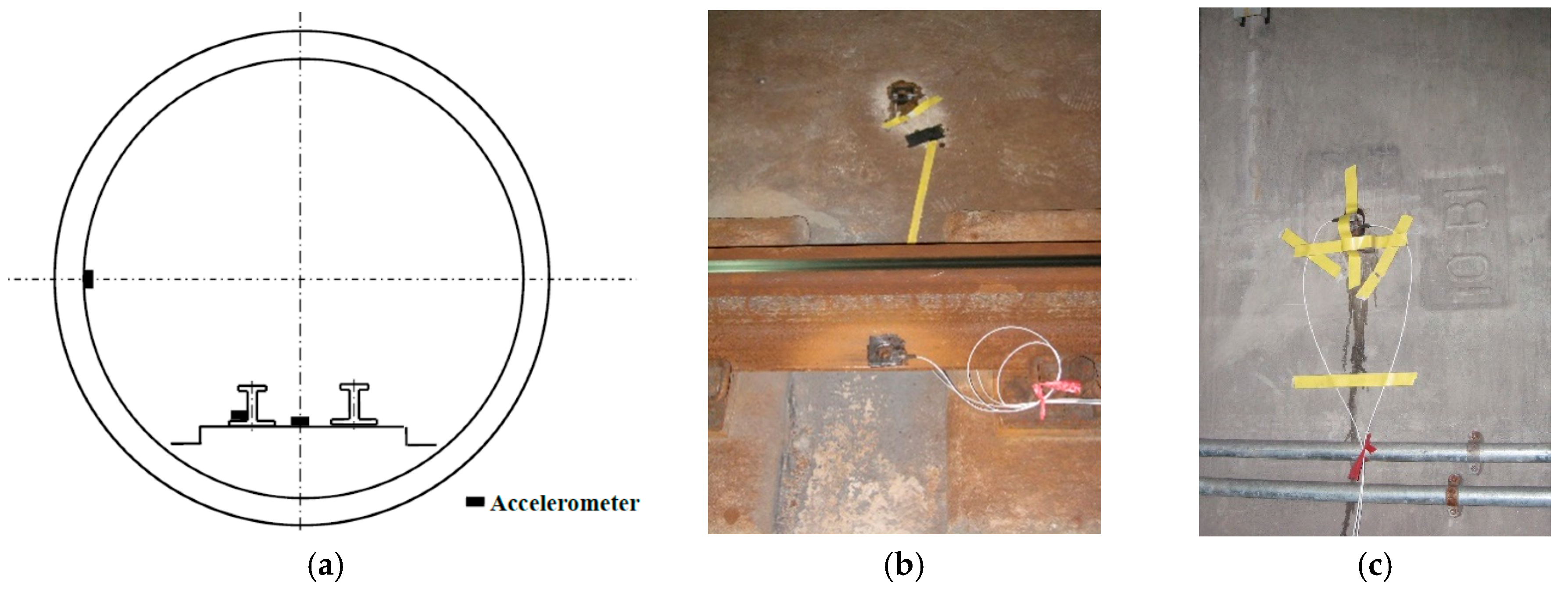
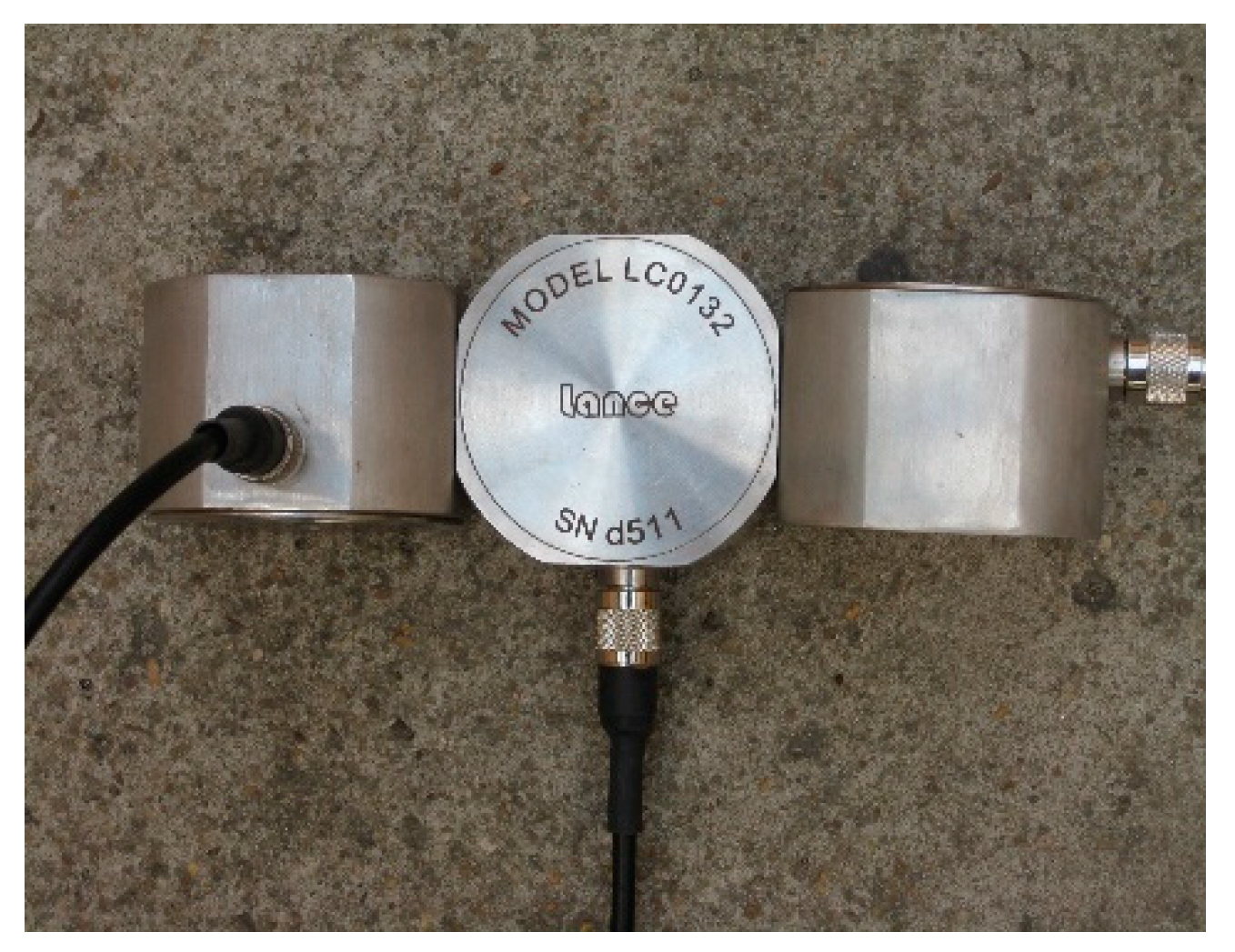
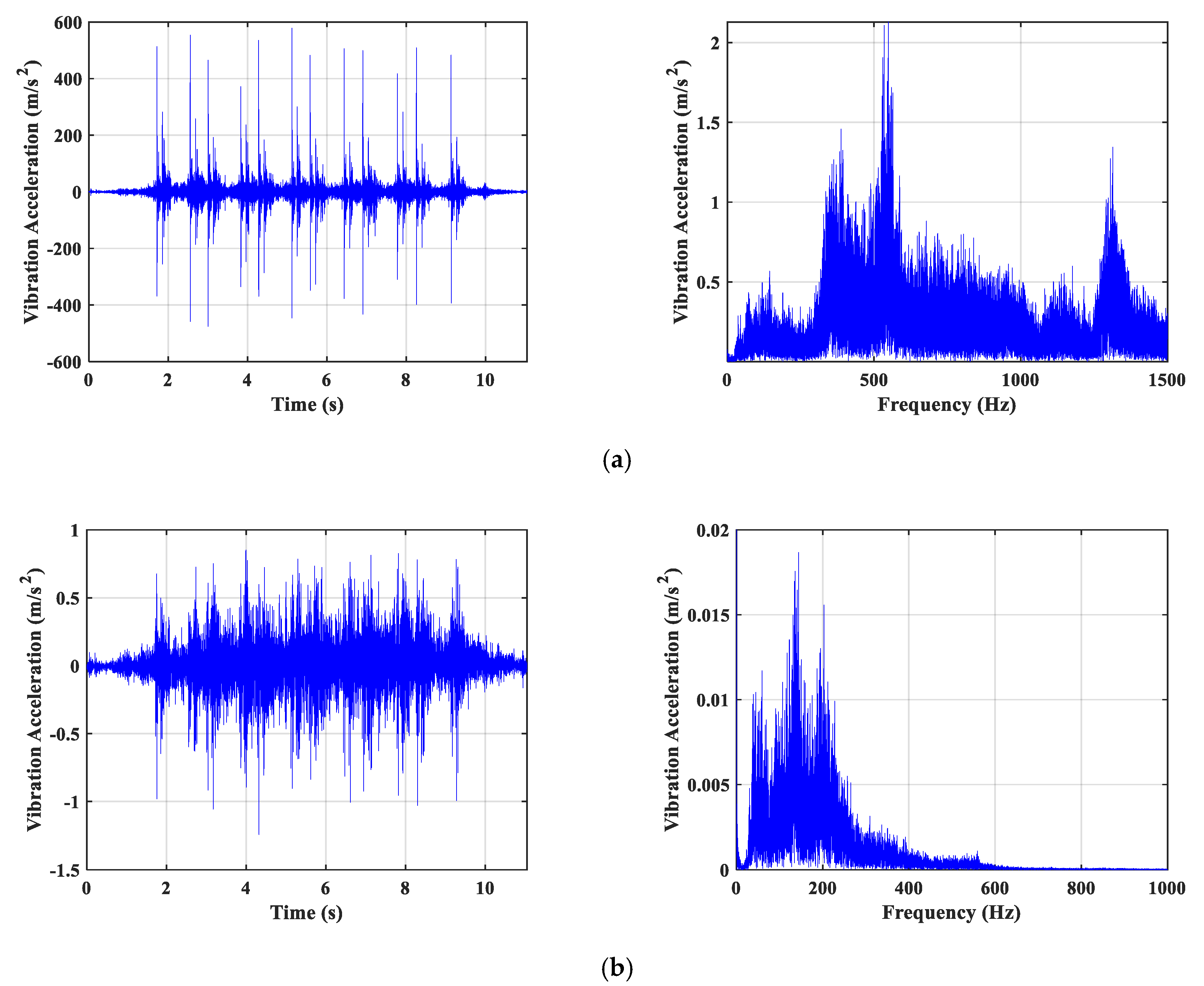
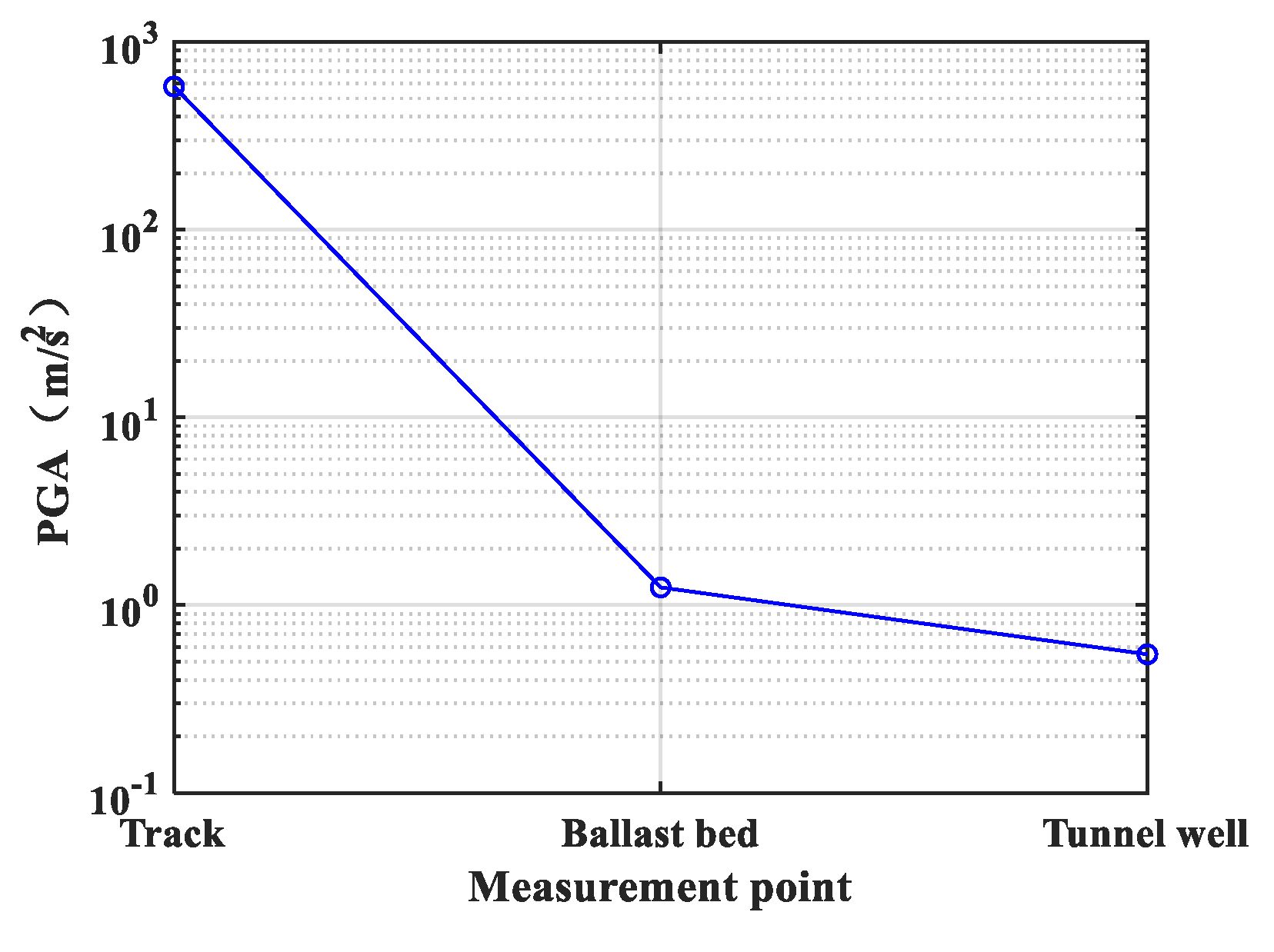

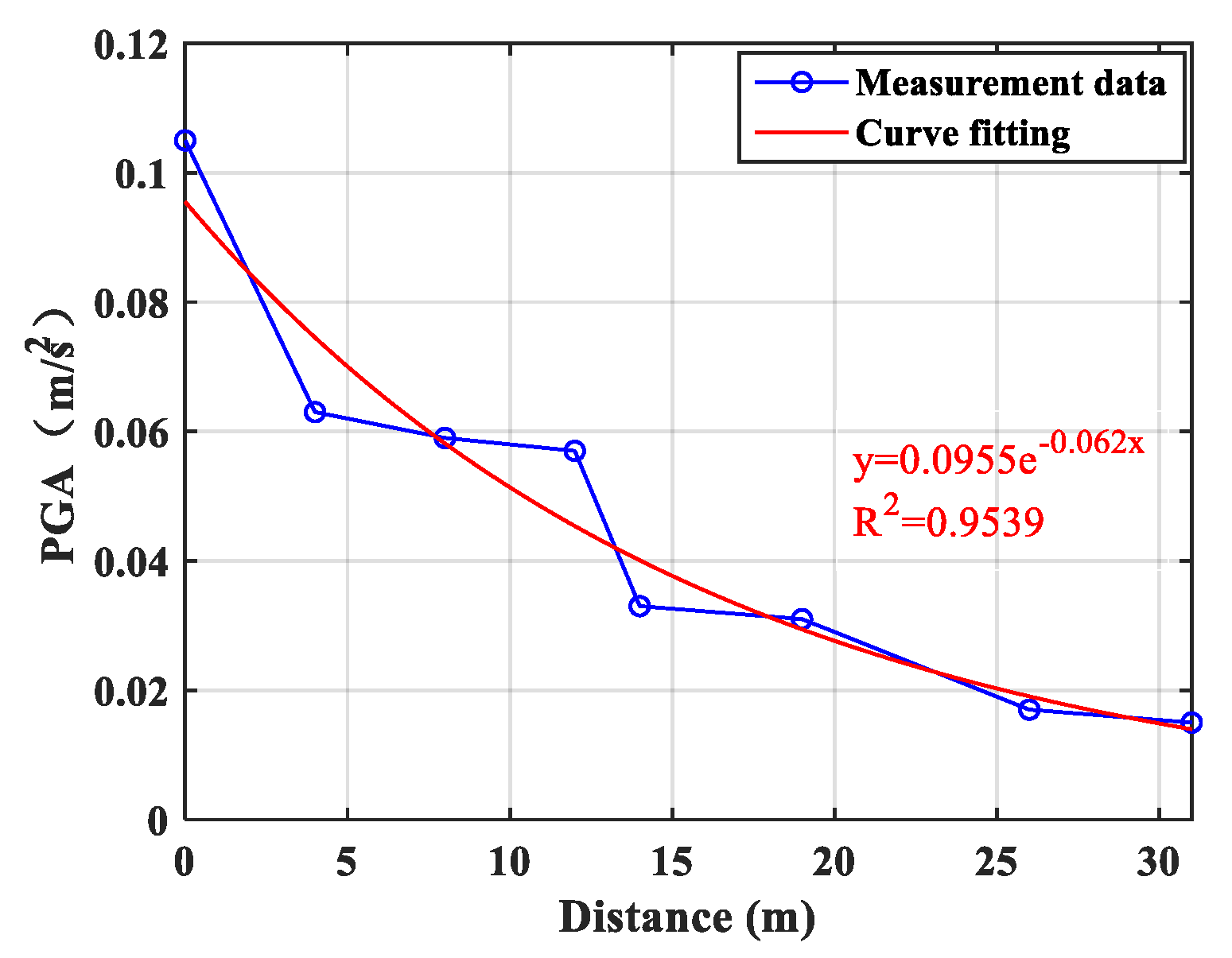

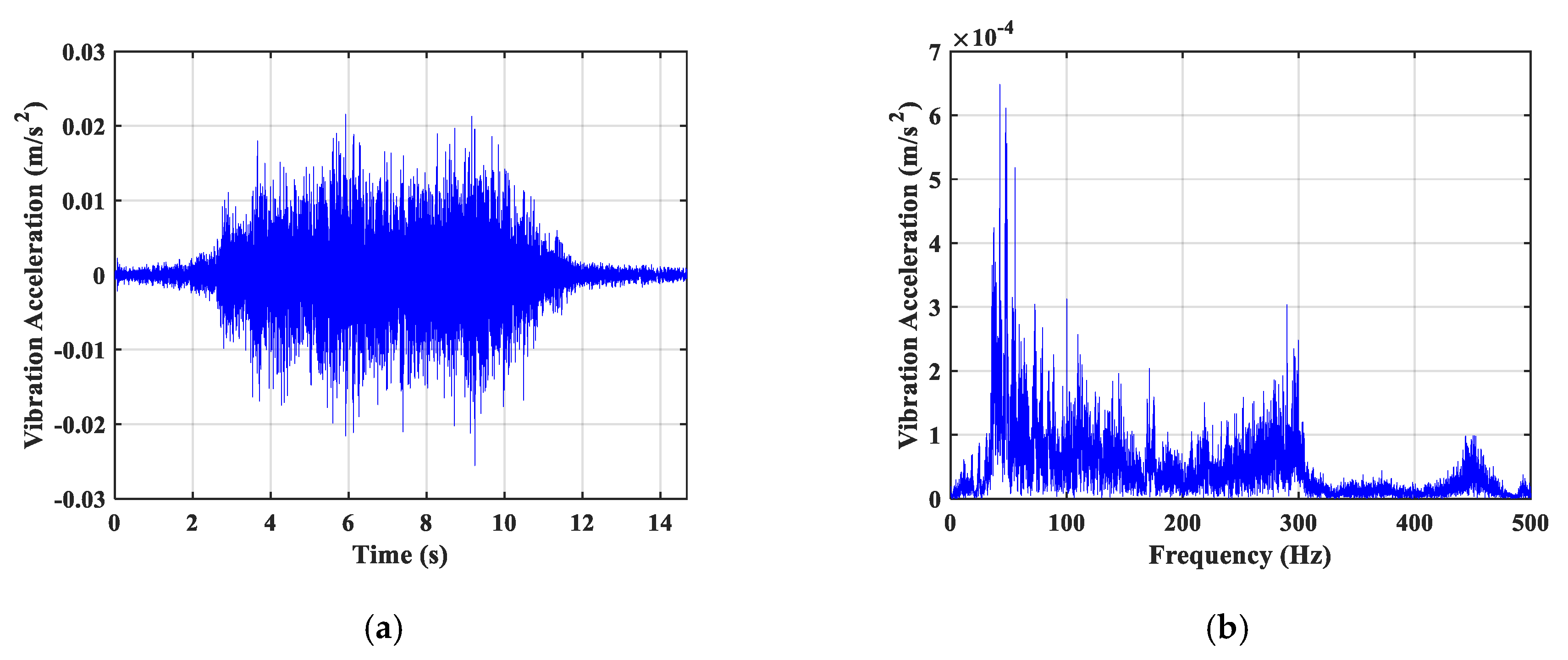

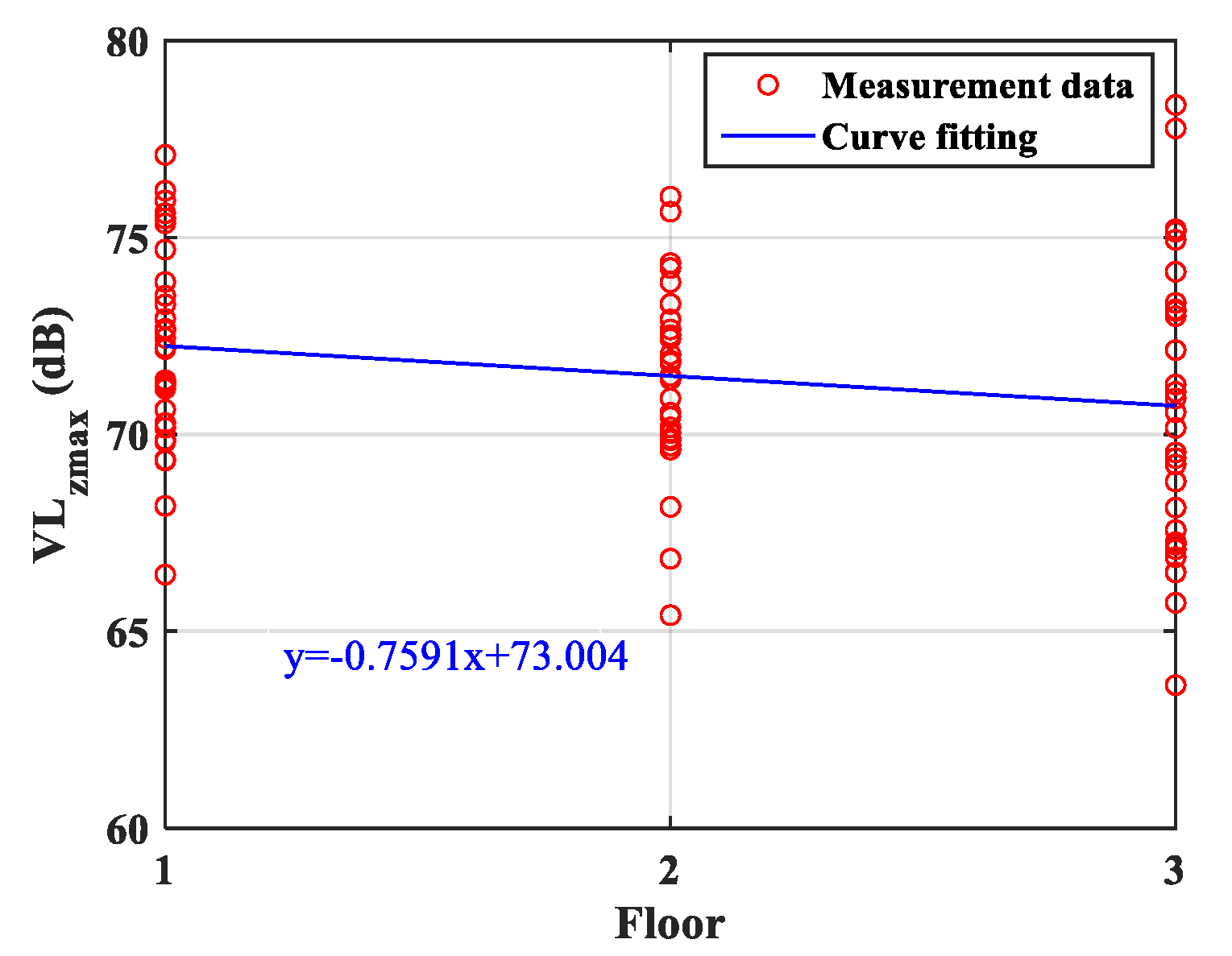
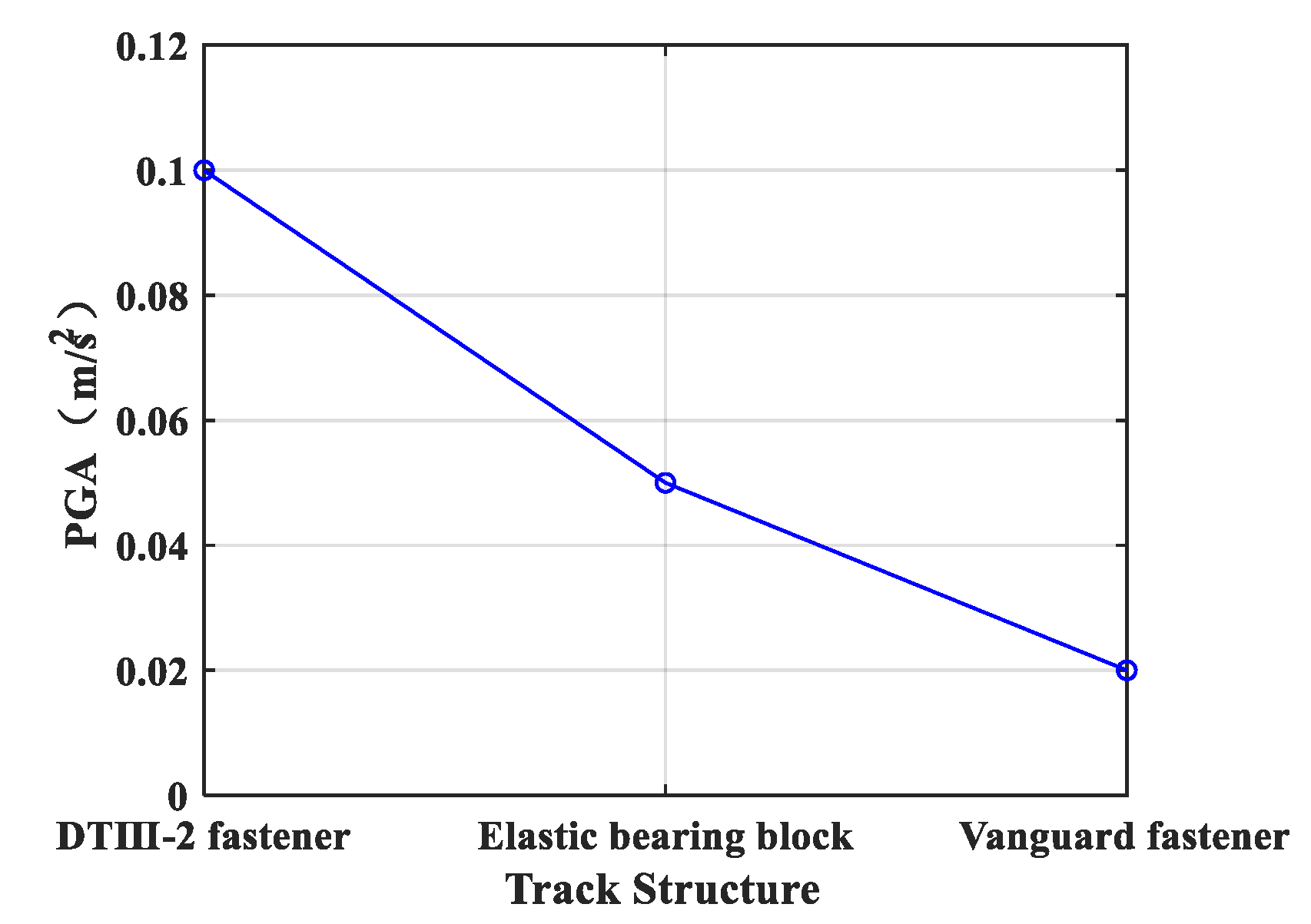
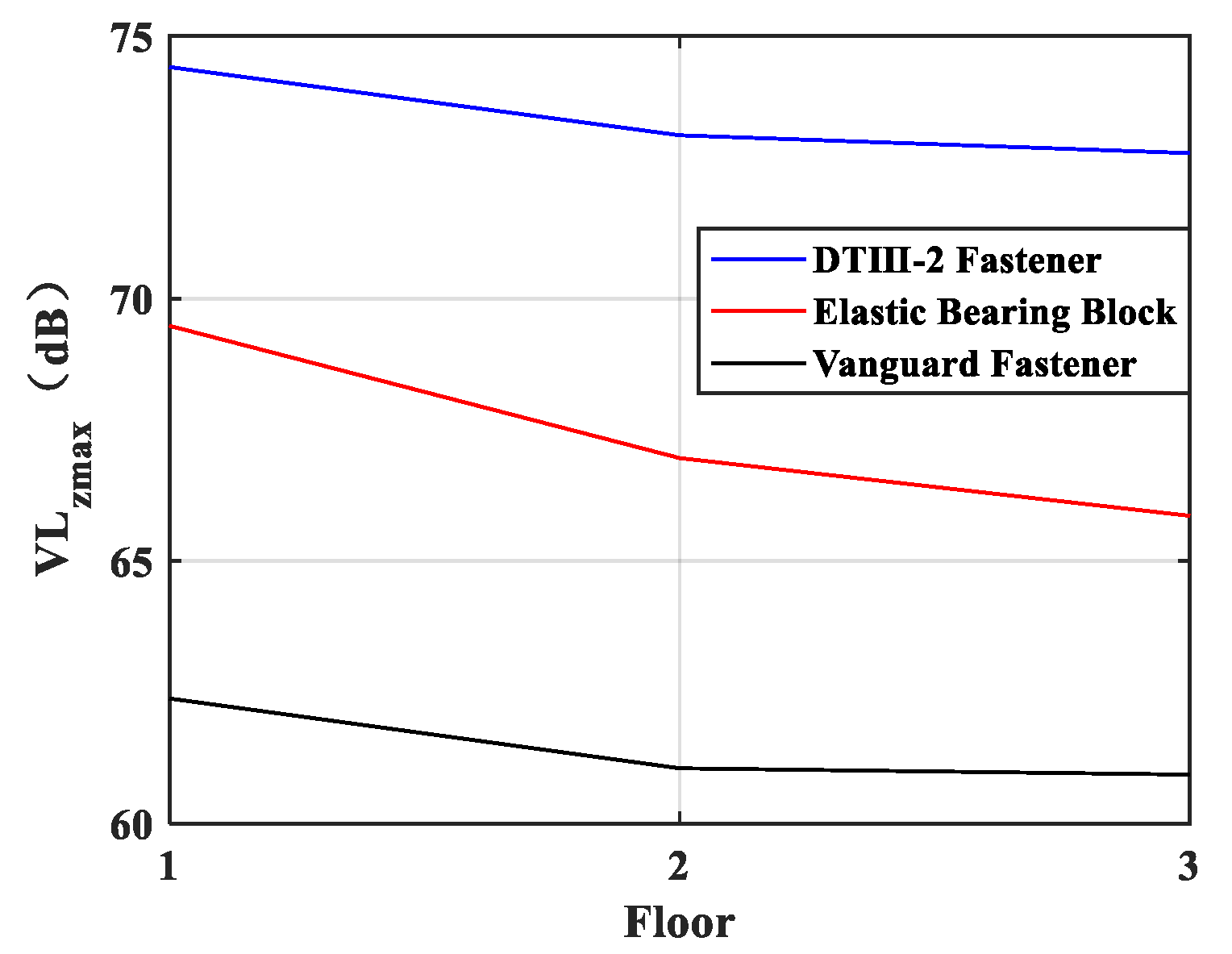
© 2019 by the authors. Licensee MDPI, Basel, Switzerland. This article is an open access article distributed under the terms and conditions of the Creative Commons Attribution (CC BY) license (http://creativecommons.org/licenses/by/4.0/).
Share and Cite
Xu, R.; Li, X.; Yang, W.; Rabiei, M.; Yan, C.; Xue, S. Field Measurement and Research on Environmental Vibration due to Subway Systems: A Case Study in Eastern China. Sustainability 2019, 11, 6835. https://doi.org/10.3390/su11236835
Xu R, Li X, Yang W, Rabiei M, Yan C, Xue S. Field Measurement and Research on Environmental Vibration due to Subway Systems: A Case Study in Eastern China. Sustainability. 2019; 11(23):6835. https://doi.org/10.3390/su11236835
Chicago/Turabian StyleXu, Rui, Xunchang Li, Wei Yang, Minou Rabiei, Chenglong Yan, and Songtao Xue. 2019. "Field Measurement and Research on Environmental Vibration due to Subway Systems: A Case Study in Eastern China" Sustainability 11, no. 23: 6835. https://doi.org/10.3390/su11236835
APA StyleXu, R., Li, X., Yang, W., Rabiei, M., Yan, C., & Xue, S. (2019). Field Measurement and Research on Environmental Vibration due to Subway Systems: A Case Study in Eastern China. Sustainability, 11(23), 6835. https://doi.org/10.3390/su11236835





